- Market Overview: Weekend Market Analysis
- 30-year Treasury Bond futures
- Bond futures are at apex of a triangle on weekly chart
- EURUSD Forex market
- EURUSD weekly chart broke strongly above its 4-month trading range
- S&P500 Emini futures
- Monthly Emini chart has buy climax above weak bull flag
- Weekly S&P500 Emini futures chart has wedge rally at measured move target
- Daily S&P500 Emini futures chart has nested wedge rally, but no sell signal bar yet
Market Overview: Weekend Market Analysis
The SP500 Emini futures have rallied for a month, but there are problems with the rally on the daily, weekly, and monthly charts. There is a nested wedge rally at a measured move target on the daily chart. Traders should expect a pullback to below 3400 to begin in December.
Bond futures are probably in a bear trend that will last for a decade. They are currently at the apex of a triangle, and a bear breakout is more likely.
The EURUSD Forex broke far above the 4-month trading range that formed after a strong summer rally. Traders expect a test of the February 2018 high above 1.25 in 2021. But the EURUSD might pull back to test the September high, or even the November low first.
30-year Treasury Bond futures
Bond futures are at apex of a triangle on weekly chart
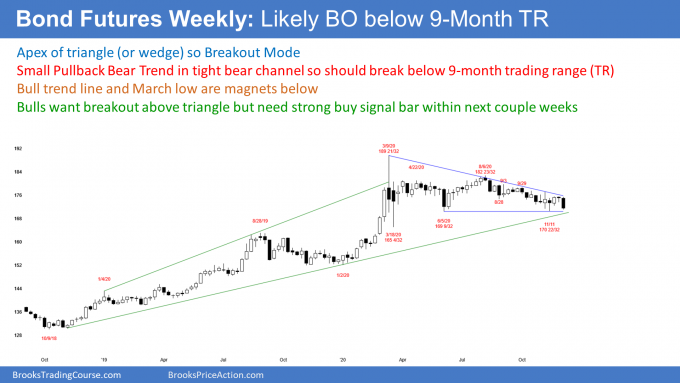
The weekly bond futures market has been sideways for 9 months after a reversal down in March from the most extreme buy climax in history. The trading range has lower highs, and is therefore a triangle (or a wedge). That does not change the probabilities for the direction of the eventual breakout because every trading range is a Breakout Mode pattern. However, it is often a sign that a breakout might be imminent.
It is important to know some generalities about Breakout Mode patterns. The 1st breakout of a Breakout Mode pattern has a 50% chance of failing. Furthermore, there is a about a 50% chance that once there is a successful breakout, it will be up, and about a 50% chance that it will be down. Finally, there are often several failed breakouts before there is a successful breakout. The failed breakouts simply increase the height of the trading range.
Will the breakout be up or down?
I wrote many times since March that the bond market would probably be in a tight range for the remainder of 2020, which it has been. When there is a reversal down from an extreme buy climax, traders expect at least a couple legs sideway, which usually takes about 10 bars. Since this buy climax was also on the monthly chart (not shown), I have been saying that the trading range would probably last at least a year.
After a 30-year rally and a reversal down from a massive buy climax, the bond market will be lower 5 and 10 years from now. However, it could easily test the August high at the top of the trading range first. Currently, it probably will not. It is even possible that it could rally briefly above the March high before the bear trend begins, but that is unlikely.
Trading ranges can last a long time
The chart could remain sideways for another year or more before it clearly trends down strongly. Also, it could work back up to the top of the trading range at the August high before falling further. Finally, it could break out below, and then rally for many weeks before resuming down. The bonds market is in a trading range, so traders are open to anything, and nothing is high probability over the short-run.
Are there characteristics about this trading range that make a bear breakout more likely? Yes. The most important is the strong reversal down in March from the most extreme buy climax in history. While the bond market has not resumed up in 9 months, it also has not retraced much of the 2-year extreme rally. That makes it likely that it will retrace more.
Also, the selloff for the past 5 months has been in a tight bear channel. That is a strong, sustained leg down. It increases the chance of a bear breakout. But if the bulls get a strong reversal up within the next few weeks, traders will then look for a rally to the middle of the trading range.
As I said, bonds will be down for years. That does not mean straight down. There will be many strong rallies. Since the bond futures are at the bottom of a trading range, they might rally for a month or two before resuming down. But they are going down.
The appearance of the breakout bars is important
If there is a bear breakout, traders will pay attention to what the bars look like. If there are consecutive big bear bars closing on their lows, and far below the June low, traders will look for at least a couple legs down and a test of the next support. That is the March low.
But if the breakout reverses up strongly either immediately, or within a couple bars, traders will look for a test of the top of the trading range at the August high.
If the breakout is unclear, the bond market will likely go sideways for a few bars before traders decide whether it will succeed or fail.
What about zero interest rates?
I want to remind readers that until a few months ago, the idiots on TV were still saying that we would have negative interest rates in the U.S. and that bonds were therefore going higher. I repeatedly said for over a year that this was wrong, and that the US public would never allow the government to have negative interest rates.
This is still true. The U.S. will not have negative interest rates. In fact, the TV clowns have finally stopped their catchy chant of «interest rates to zero and gold to infinity.» Just because something sounds clever does not make it true.
EURUSD Forex market
EURUSD weekly chart broke strongly above its 4-month trading range
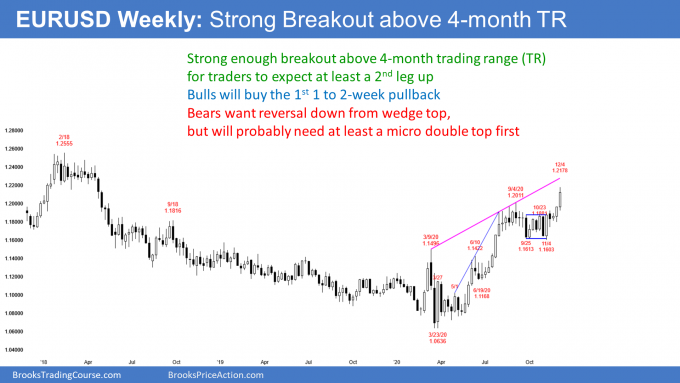
The EURUSD weekly chart this week broke far above the September high. This increases the chance of follow-through buying next week. If next week is a 2nd consecutive big bull bar, traders will look for a test of the February 2018 major lower high around 1.25 within a couple months.
Next week is the follow-through bar. If it is not clearly bullish or bearish, the EURUSD might go sideways for a week or two before deciding whether to continue up or reverse down. At the moment, there is a 60% chance it will go higher, unless next week is a bear bar closing on its low.
If next week is a big bear bar closing on its low, traders will conclude that the breakout failed. They would then think that the reversal is a wedge top, where the March 9 and September 1 highs were the 1st 2 legs up. They would expect a couple legs sideways to down, to at least the breakout point at the September 1 high. It could test the November 4 low at the bottom of the 3rd leg up.
The rally is already at a minor resistance level, which is a measured move based on the height of the November 4 bar. That was a 2nd consecutive outside bar on the weekly chart, and traders expected the breakout to reach a measured move. That means that their could be a minor pullback here. However, traders expect higher prices and they will buy the 1st pullback, unless it is a strong reversal down.
S&P500 Emini futures
Monthly Emini chart has buy climax above weak bull flag
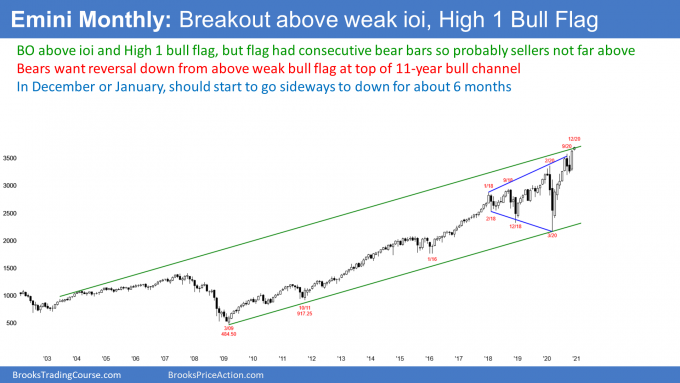
The monthly S&P500 Emini futures chart formed a huge bull bar in November. It closed above the October high and at a new all-time high.
December gapped up, which meant there was a gap up to a new all-time high on the monthly chart. That is extremely rare. While I did not check, it might be the only time in the history of the Emini and S&P futures.
However, the gap on the monthly chart was small. Small gaps typically close before the bar is complete. This gapped closed when Wednesday dipped below the November high.
Follow-through after a breakout is important
December is important because it is the bar after a breakout. It is the follow-through bar, and its appearance can change expectations of traders for the coming months. If December is a big bull bar closing on its high, traders will expect at least 2 legs up. This is the most bullish outcome. Traders would hope for a 400-point measured move up based on the height of the 4-month trading range.
The bears want December to be a big bear bar closing on its low. Traders would then assume that November was a bull trap, and they would look for a reversal down.
Most likely, December will not be either a strong bull or bear bar. Anything other than a strong bear bar will leave traders expecting sideways to up trading in January.
Don’t forget that the High 1 buy signal bar was a bear bar
I mentioned at the end of October that October was a High 1 bull flag buy signal bar, but that it had a bear body. Also, it was a 2nd consecutive bear bar, and the bull flag was coming late in a bull trend.
That combination is not good for the bulls. Usually a bull breakout will only last for a bar (month) or two, and then there is a reversal sideways to down. The reversal down typically has at least a couple legs and lasts at least 5 bars. Since this is a monthly chart, 5 months is about half of a year. Consequently, traders should expect 2021 to be sideways to down for the 1st half of the year, whether or not the Emini continues up into January.
This particular High 1 was an inside bar after an outside bar. It is therefore also an ioi (inside-outside-inside) Breakout Mode pattern. A Breakout Mode pattern late in a bull trend is often the Final Bull Flag.
The bulls hope that any pullback will form a triangle, which would be another bull flag. However, the bears want a reversal down from a higher high micro double top with the September high.
The important point is that traders should expect that there will not be strong, protracted buying in the coming months. Instead, they should watch for a reversal down in either December or January. For example, December could rally and sell off, which would create a bear reversal bar.
Alternatively, it could simply be sideways and in a small range, and close near the open. While that is not a strong sell signal bar, it could be the start of a couple legs sideways to down.
Weekly S&P500 Emini futures chart has wedge rally at measured move target
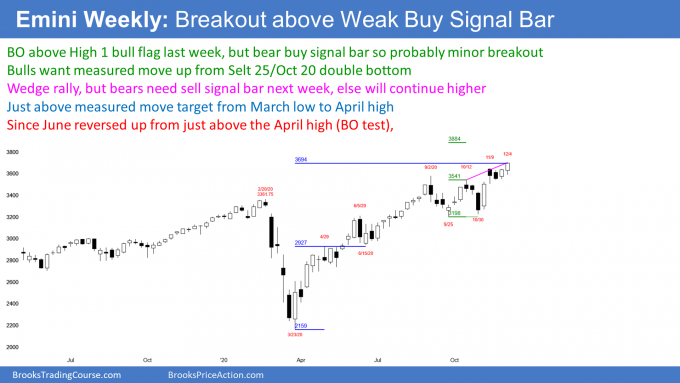
The weekly S&P500 Emini futures chart has had consecutive bull bars after breaking above a High 1 bull flag last week. However, the buy signal bar was a bear bar, and it was a 2nd consecutive bear bar.
This is similar to what is taking place on the monthly chart. When there is a weak bull flag coming late in a bull trend, the rally usually fails within about 2 bars. This week was the 2nd bar. That increases the chance of a reversal down next week.
What about the consecutive bull bars? Yes, they increase the chance of at least slightly higher prices next week. With this week closing near its high, next week might even gap up on the weekly chart. While unlikely at the moment, the Emini might reach the 3884 measured move target based on the September/October double bottom. But a 3rd consecutive strong bull bar would be unusual in this situation. Therefore, if this coming week rallies, traders should look for a reversal down later in the week.
Wedge rally to measured move target
There is a credible wedge rally from the September low. What makes it particularly important is that this week is also at a measured move target.
When there is a bull trend and a reversal down, the reversal down fails and the bull trend resumes. If that happens, you should assume that the reversal down was testing something.
What did it test? Look to the left. The June low was a test of the April high. The Emini reversed back up from just above that high, and therefore that high is important. There is now a gap between those 2 prices. Two important prices often lead to a measured move, which is then a 3rd important price.
If you project up from the March pandemic low to the bottom of the gap at the April high, the measured move target is 3694. The Emini poked above it on Friday, and closed just above it.
Yes, this week was also a test of the 3700 Big Round Number, but that gap is important. If the bears get a sell signal bar next week, that measured move target increases the chance of a couple legs down.
If there is a reversal down, where is support?
The September/October trading range had both a double bottom and a double top. A symmetrical trading range late in a bull trend is an area of agreement. If the market breaks above it, it usually gets pulled back to the middle or bottom of the range. That range is often the Final Bull Flag.
The middle of the range is between 3400 and 3500. If the selloff is strong, traders will expect a test of the bottom of the range, which is around 3200.
Daily S&P500 Emini futures chart has nested wedge rally, but no sell signal bar yet
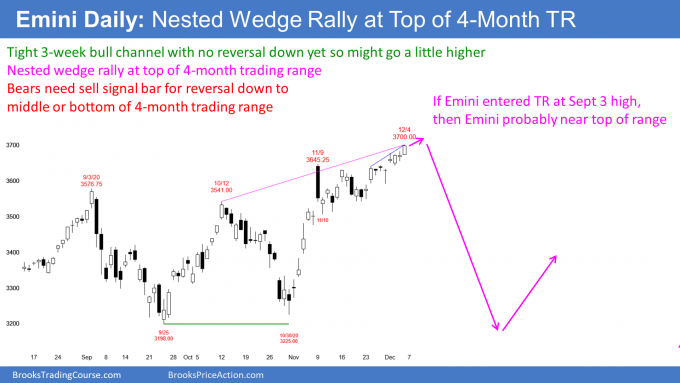
The daily S&P500 Emini futures chart has rallied strongly from the September/October double bottom. This week broke above a 3-week trading range to a new all-time high.
But there is something wrong with the daily chart, in addition to the bad bull flags on the weekly and monthly charts. It’s the bars. In a bull trend that lasts a long time, at least half of the bars in the legs up have closes on or near their highs. Since late October, most of the bars have closed in the middle or near the open.
Neutral bars like that are much more common when a rally is a leg in a trading range. Bull legs in trading ranges lead to bear legs. While it is certainly possible that the November rally could accelerate up in December and begin a clear bull trend, it is currently more likely that it will lead to a bear leg in the 4-month trading.
Sometimes a market will accelerate up for a few days and then collapse. That is a blow-off top, and a buy climax like that often is the start of a swing down.
But didn’t this week break above the 4-week range, which is at the top of the 4-month range? It did, but most trading ranges that last 20 or more bars have at least one failed breakout. That means a new high or new low that reverses. The longer a trading range lasts, the more likely there will be a breakout up or down that fails.
Nested wedge rally
There is another problem with the rally. There are 3 small pushes up over the past 3 weeks. A reversal down would make traders view the rally as a wedge.
A small wedge usually leads to a minor reversal down. But this small wedge is nested within a bigger wedge that began with the October 12 high. A nested wedge pattern has a higher probability of leading to a reversal down, and the reversal down tends to be deeper and last longer. Finally, remember that this is coming at the resistance of the measured move target on the weekly chart, and the 3700 Big Round Number.
If the bears get a reversal down next week, traders should expect it to be fairly deep and last at least a couple weeks. As I wrote above, reasonable targets are the middle and the bottom of the 4-month trading range.
But what if there is no reversal? The market has been rallying strongly for a month. The bulls will look for a measured move up to 4,000 – based on the 400-point tall trading range that began in September.
Is the Emini in a new bull trend?
The question is, is the daily chart still in a trading range, or has the breakout been convincing enough so that traders believe there is now a new bull trend? Unless the bulls start to get more and consecutive bull bars closing near their highs, this week’s breakout will fail. Traders will see it as a new high in the 4-month trading range, and they will look for a reversal down. With everyone on TV so bullish, if the Emini starts down, it could fall quickly as everyone suddenly realizes that they are long at the top of a trading range.
But if the Emini begins to form many bull bars closing on their highs, then traders will conclude that the rally is in fact the start of a new leg up. The target above is the 4,000 Big Round Number, which is about a measured move up from the 4-month trading range.
If the Emini reverses down soon, how far down will it go? At a minimum, traders will look for it to get back to the middle of the 4-month range. That is around 3400, and it is below the November 10 higher low. Traders should not be surprised if it goes all the way below the 3200 bottom of the range.
Remember what I wrote about the monthly chart. It looks like the Emini will be sideways to down for the 1st half of 2021, even if it goes higher into January. If so, the Emini should get down to the bottom of the range by mid-year, and probably sooner.
Trading Room
Traders can see the end of the day bar-by-bar price action report by signing up for free at BrooksPriceAction.com. I talk about the detailed Emini price action real-time throughout the day in the BrooksPriceAction.com trading room. We offer a 2 day free trial.
Charts use Pacific Standard Time
When I mention time, it is USA Pacific Standard Time (the Emini day session opens at 6:30 am PST, and closes at 1:15 pm PST). You can read background information on the intraday market reports on the Market Update page.

